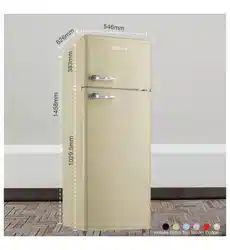Loading ...
Loading ...
Loading ...

7
www.linarie.com.au
8. STORAGE OF FOOD
Your appliance has the accessories as the
“Structure illustration” showed in general,
with this part instruction you can have the
right way to storage your food.
The glass shelves and crisper can be removed
to store food if needed.
Note:
Food is not allowed to touch directly all
surfaces inside the appliance. It has to be
wrapped separately in aluminum sheet or in
cellophane sheet or in airtight plastic boxes.
Store foods that are very fresh and of good quality.
Ensure that food is well wrapped or covered before
it is stored. This will prevent food from dehydrating,
deteriorating in colour or losing taste and will help
maintain freshness. It will also prevent odour transfer.
Vegetables and fruit need not be wrapped if they are
stored in the vege
table container
of the fridge compartment.
Make sure that strong smelling foods are wrapped or
covered and stored away from foods such as butter,
milk and cream which can be tainted by strong odours.
Cool hot foods down before placing them in the fridge
compartment.
Storing food in the refrigerator compartment
The fridge freezer compartment helps to extend the
storage times of fresh perishable foods.
Fresh food care for best results:
Most pre-packed dairy foods have a recommended 'use
by /best before/best by/ date stamped on them.
Store them in the fridge compartment and use within the
recommended time.
Butter can become tainted by strong smelling foods so
it is best stored in a sealed container.
Eggs should be stored in the fridge compartment.
Dairy foods and eggs
Place fresh red meat on a plate and loosely cover with
waxed paper, plastic wrap or foil.
Store cooked and raw meat on separate plates.
This will prevent any juice lost from the raw meat from
contaminating the cooked product.
Red meat
Packaging must not be damaged.
Use by the 'use by /best before/best by/' date.
If possible, transport deep-frozen food in an insulated
bag and place quickly in the freezer compartment.
Purchasing frozen food
Freeze fresh and undamaged food only.
To retain the best possible nutritional value, flavour and
colour, vegetables should be blanched before freezing.
Aubergines, peppers, zucchini and asparagus do not
require blanching.
Note:
Keep food to be frozen away from food which is already
frozen.
The following foods are suitable for freezing:
Cakes and pastries, fish and seafood, meat, game,
poultry, vegetables, fruit, herbs, eggs without shells,
dairy products such as cheese and butter, ready meals
and leftovers such as soups, stews, cooked meat and fish,
potato dishes, soufflés and desserts.
The following foods are NOT suitable for freezing:
Types of vegetables, which are usually consumed raw,
such as lettuce or radishes, eggs in shells, grapes,
whole apples, pears and peaches, hard-bo
iled eggs,
yoghurt, soured milk, sour cream, and mayonnaise.
Freezing fresh food
Store at -18°C or colder. Avoid opening the freezer
compartment door unnecessarily.
Storing frozen food
Fresh whole birds should be rinsed inside and out with
cold running water, dried and placed on a plate.
Cover loosely with plastic wrap or foil.
Poultry pieces should also be stored this way.
Whole poultry should never be stuffed until just before
cooking, otherwise food poisoning may result.
Poultry
These should be stored in suitable covered containers
so that the food will not dry out.
Keep for only 1-2 days.
Reheat leftovers only once and until steaming hot.
Precooked foods and leftovers
The vegetable container is the optimum storage location
for fresh fruit and vegetables.
Take care not to store the following at temperatures of
less than 7°C for long periods: Citrus fruit, melons,
aborigines, pineapple, papaya, curettes, passion fruit,
cucumber, peppers, tomatoes.
Undesirable changes will occur at low temperatures
such as softening of the flesh, browning and/or
accelerated decaying.
Do not refrigerate avocados (until they are ripe),
bananas and mangoes.
Vegetable container
To store deep-frozen food.
To make ice cubes.
To freeze food.
Note:
Ensure that the freezer compartment door has been
closed properly.
Freezing and storing food in the freezer
compartment
To prevent food from losing its flavor or drying out,
place food in airtight packaging.
1. Place food in packaging.
2. Remove air.
3. Seal the wrapping.
4. Label packaging with contents and dates of freezing.
Suitable packaging:
Plastic film, tubular film made of polyethylene, aluminum
foil. These products are available from specialist outlets.
Packing frozen food
Loading ...
Loading ...
Loading ...
